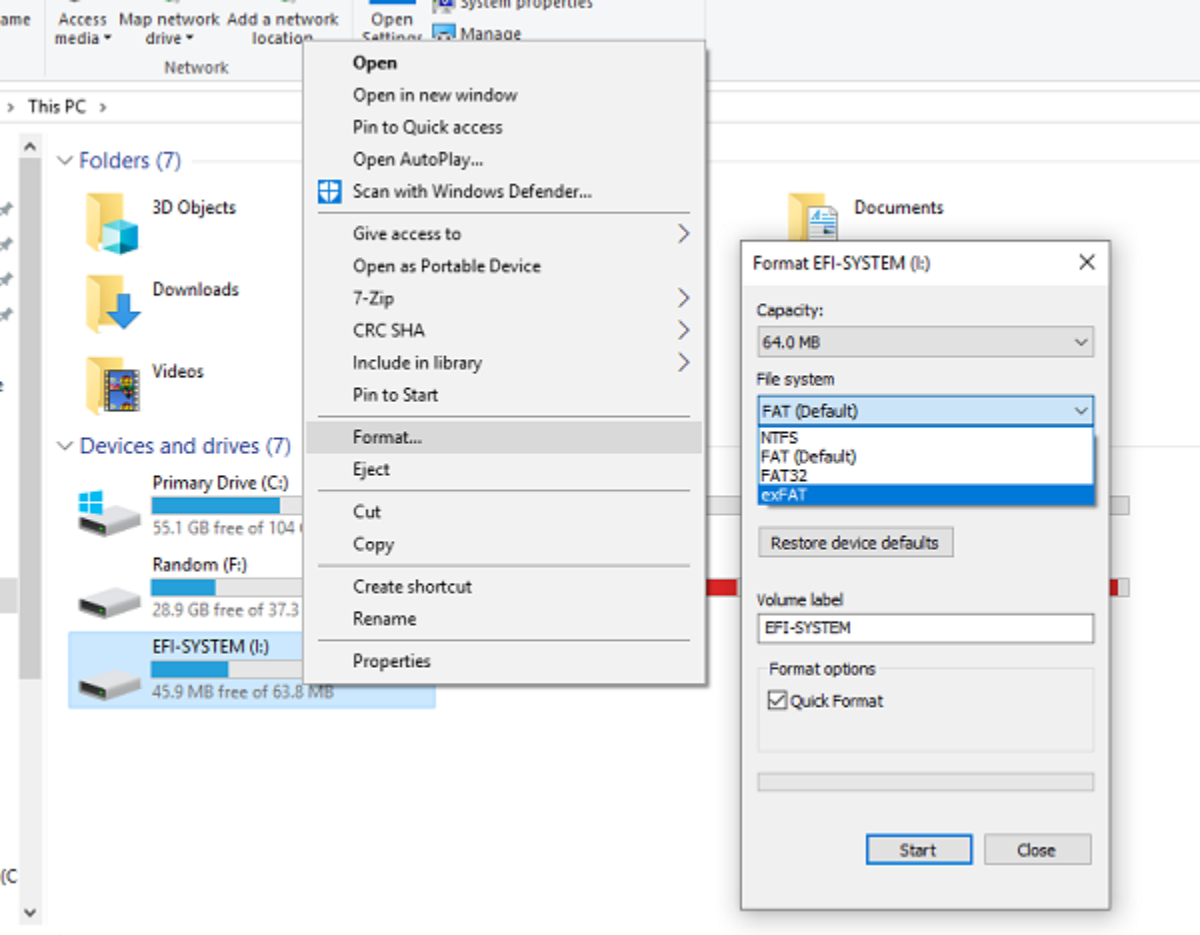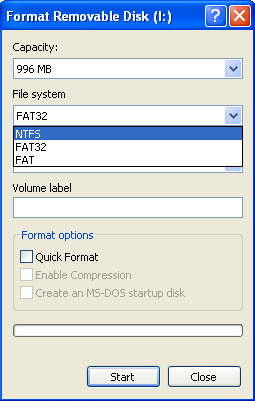Dec 03, 2020 • Filed to: Windows Computer Solutions • Proven solutions
- As the second disk formatting tool tested and listed here, USB disk storage format tool is also 100% freeware and allows people to completely format any USB flash drive or memory card with FAT, FAT32, exFAT and NTFS file system formats. Download Free Now. Pros:.It is free, fast and safe to format a flash drive or memory card.
- In fact, unless you have a compelling reason to change the default format, I’d leave the format of any USB stick or flash-based memory card exactly as it came. “Compelling reasons” include the additional performance that might be gained from an NTFS or exFAT file system, or the ability to store files larger than 4GB.
I needed to perform an offline system update for Xbox One S but I only have Macs. Installed the Paragon NTFS for Mac using 10 day trial. That allowed me to format a USB drive as NTFS with full read-write access and then write the system update files to the USB drive. Offline Xbox update worked like a charm via USB stick. – Brian D Dec 2 '19.
USB Flash Drives are the new file briefcase in this world of technology. It allows you to store as many files you want within a little device. It makes files very compact, easily transportable, and organized. However, just like with a filing system used in paperwork, USB drives also make use of file systems. The most common file systems used are NTFS, exFAT, and FAT32. If you’ve been using flash drives and other external storage devices for a long time, you may be already familiar with this. Each file system has its pros and cons. Many PC users are opting to format or change their file systems to NTFS. If you’re unfamiliar with the file system and have no idea why this needs to be done, keep on reading. In this article, we will provide you with three easy ways you can format your USB drive to NTFS.
Why Do You Need To Format a USB Drive to NTFS?
The default format used by most USB flash drives and other external storage media is FAT32. Some people are fine with keeping this format. But for most users, they always find the need to convert or format their USB drive to NTFS. This is for many reasons. With a USB drive that uses the FAT32 file type, you can only copy or add files less than 4GB. This may be a hassle for some users who want to transport large files like movies, program installers, etc. Meanwhile, NTFS doesn’t have this limitation. You can copy or add files of any size and the partition sizes usually have a large capacity.
What is NTFS?
NTFS is a type of file system. It stands for the NT File system and is also called the New Technology File System. It’s a way of organizing files within a flash drive. It’s a new improvement from previous file types like File Allocation Table (FAT) or Extended File Allocation Table (exFAT) previously used by Microsoft Windows. Because it’s a relatively new file type, it has increased security from its new features like file permissions and encryptions. NTFS also has a Change Journal where the driver keeps track of the changes made within the drive. This means that if ever your PC unexpectedly shuts down or you experience a system crash, you can recover files that were lost during the event.
Here are three proven methods on how to format USB flash drive to NTFS.
Method 1. Format USB Flash drive to NTFS using Disk Management
1. Find My Computer in the Start menu or by typing it in the search bar. Right-click on it and click on Manage.
Ntfs Format Download
2. In Device Manager, look for your USB drive in the Disk Drives tab.
3. Right-click on your drive and choose Properties.
4. Under the Policies tab, click on Optimize for performance. Select OK.
Format Flash Drive Mac Ntfs
5. Go to My Computer and look for your drive. Right-click and choose Format in the drop-down menu.
6.In the format options that will pop-up, select NTFS to convert your drive to NTFS.
7. Select Start and wait for the process to finish.
Method 2. Format USB flash drive to NTFS using Command Prompt
Using Command Prompt, make sure to type in the exact commands to avoid unexpected errors.
1. Launch Command Prompt by typing in cmd in the Run tool or typing Command Prompt in the search bar. Select Run as administrator.
2.Type in the command:
convert G: /fs:NTFS
NOTE: In this command, we’re formatting drive G. Change this to whatever drive letter you’re trying to work with.
Method 3. Formatting your USB drive using Windows tools
You can easily format your USB drive with just the built-in features of your Windows computer. Follow the steps below to perform this:
1. Plug the USB drive into the USB port of your computer or laptop.
2. Go to My Computer and right-click on your USB drive. A drop-down menu will appear. Choose Format…
3. The format window will open. Here you will see the device’s capacity, File System, and Allocation unit size. You can also rename the volume label. The Restore device defaults button will revert your drive’s settings to default. You can change the file system in NTFS or FAT and also assign the unit size.
4. Select the Start button at the bottom of the window and click OK to begin the format and erase all the data contained in the drive.
Formatting your USB drive may seem intimidating at first. Formatting changes the file type of your drive and along with this, also wipes out all the data saved within. So it’s important to back up all the files to your computer or another drive before performing any format. With any of the methods previously mentioned above, you will be able to perform a format of your USB flash drive easily and quickly.
Video Tutorial on How to Recover Lost/Deleted Partition Data?
Partition Recovery
- Partition Management
- Solve Partition Problems
- Partition Tips

One of the most usual problems encountered in file transfer between Mac and PC using a disk has something to do with disk format. Windows natively support the FAT and NTFS files systems, while Mac uses Apple File System and macOS Extended as the default file system. It’s well-known that Apple macOS has limited support for hard drives formatted in NTFS. When you insert an NTFS external drive in your Mac, you can only read from but not to write to the drive. In other words, you can only open and view all the files on an NTFS disk, but you can’t change them in any way, nor can you copy new files to NTFS format disks.
Wondering how to write to NTFS drives? The following will show you three solutions in detail.
Solution 1: Use paid NTFS drivers
The easiest way to bridge the gap between formats is to use third-party software. There are various apps available online that have been developed for this incompatibility issue. Some are free, but they may be difficult to set up and less reliable. So we highly recommend paid ones as they are safer and require any computer skills.

iBoysoft NTFS for Mac is the fastest NTFS driver I have ever used. It gives your Mac the ability to read and write to NTFS drives. With the software, you can delete, rename, add files and folders on NTFS formatted drives on macOS Catalina and earlier. It delivers blazing-fast read-write access to NTFS hard drives with a speed of up to six times more that of other competitors.
The program can also be used as a disk manager that enables you to unmount, erase, check and repair NTFS disks within one click. Besides handling NTFS drives, iBoysoft NTFS for Mac also impress you by formatting FA32/exFAT/HFS+/APFS drives to NTFS.
iboysoft-NTFS-for-mac-Catalina
Step 1: Download and install iBoysoft NTFS for Mac on your Mac computer.
Step 2: Plug the NTFS drives on your Mac. Once the drive is detected, a Finder window with its content will pop out. Then you can read and write to NTFS drives as you wish.

Solution 2: Use free NTFS drivers

FUSE for macOS is the most famous free NTFS driver that can let you extend the list of file systems handled by your computer. Once installed, it automatically mounts NTFS drives on Mac in read-write mode.
Note: this method will be very technical and tedious. During the process, you have to temporarily disable System Integrity Protection that is a risk for your operating system.
Step 1: Download FUSE for macOS from https://github.com/osxfuse/osxfuse/releases
Step 2: Download and install Xcode command-line tools.
- Open a Terminal window from Finder > Applications > Utilities and run the following command:
Xcode-select –install
- Click “Install” when you’re prompted to install the tools. Follow the wizard to complete the installation process.
install-Xcode
Step 3: Download and install HomeBrew.
- Go to Finder > Applications > Utilities > Terminal.
- Copy and paste the command line (Provide your password when prompt):
Step 4: Install NTFS-3G for Mac. Copy and paste the following command line, then hit Enter.
Step 5: Disable SIP (System Integrity Protection). If you want to automatically mount NTFS drives in read-write mode.
- Enter into Recovery Mode. Restart your Mac and press Command+R while it’s booting.
- Launch Terminal from the utility menu in Recovery Mode.
- Type in the command line and hit Enter.
csrutil disable
disable-sip
- After your Mac successfully disabled SIP, you need to restart the machine.
Step 6: Read and write to NTFS drives.

- Open Terminal again.
- Copy and paste the following command line and hit Enter:
Step 7: Re-enable SIP. To ensure the security of your Mac, you should enable SIP after the above operations. Hold Command+R while rebooting your computer. Then launch Terminal in Recovery Mode and run csrutil enable.
Solution 3: Enable NTFS drive write support natively
Actually, NTFS write access can be enabled natively by running some command line. But this solution is unsupported officially by Apple, which may work unstably and cause data corruption. Please back up your important data first. Within this in mind, let’s proceed.
Step 1: Connect an NTFS drive to your Apple computer.
Step 2: Go to Finder > Applications > Utilities > Terminal and type in the following command: (Enter your password when prompt)
sudo nano /etc/fstab
apple-NTFS-write-support-step-2
Step 3: You will see the fstab file that is blank. Then enter the following command (Remember to replace “VOLUME_NAME” to the name of your NTFS volume):
LABEL=VOLUME_NAME none ntfs rw,auto,nobrowse
Step5: Reconnect the NTFS drive to your Mac. You will notice the drive does not show in the Finder or desktop.
Step 6: Select “Go” and choose “Go to Folder” from the top left Finder menu.
apple-ntfs-write-support-step
How To Format Flash Drive As Ntfs On Mac
Step 7: Type in /Volumes and hit Enter.
Read Also:
Conclusion
Format Flash Drive Mac Ntfs Usb
This article has introduced you three general options to write to NTFS drives – free NTFS drivers, paid NTFS for drivers, and Apple experimental NTFS-write support. Free and open-source NTFS drivers for Mac take a bit of work to install and they are slower than paid ones. It’s full of risk to Apple experimental NTFS-write support as this method is not stable. Therefore, using paid NTFS for Mac apps like iBoysoft NTFS for Mac is the easiest way to read/write to NTFS drives on Mac. This software really surprises me for its fast speed in reading and writing to NTFS drives.